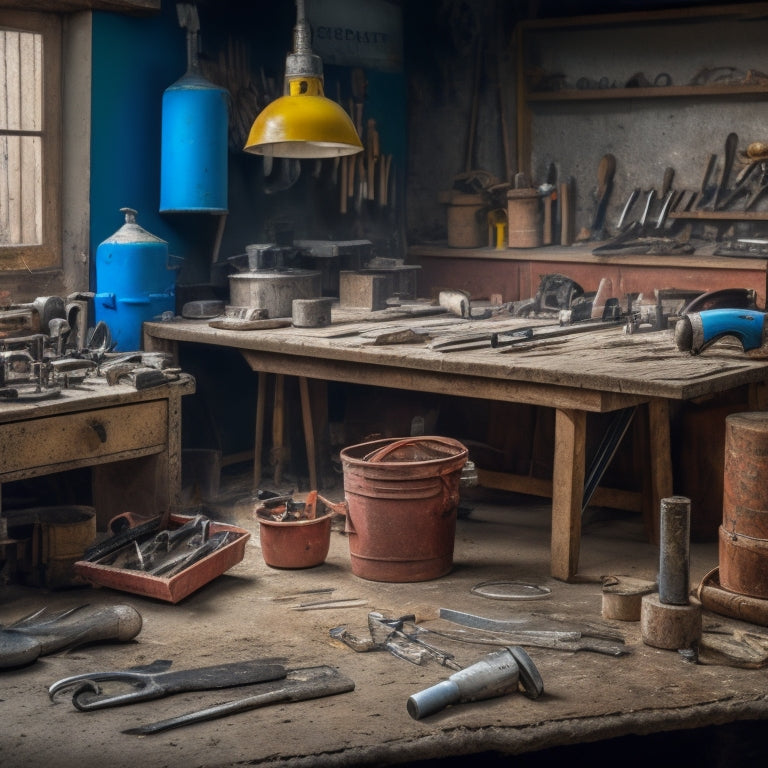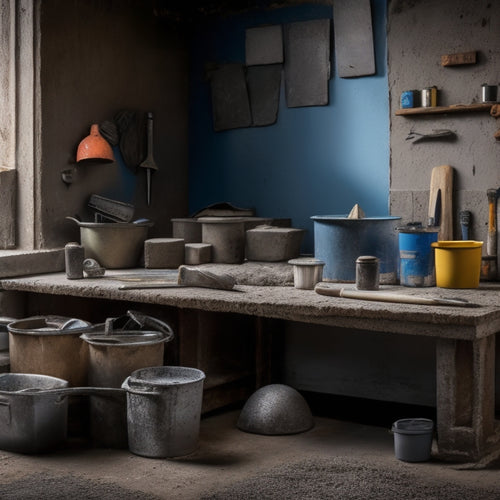
Why You Need These Concrete Repair Tools
Share
You need a thorough arsenal of concrete repair tools to effectively diagnose and address the underlying causes of common damage types, such as cracks, spalls, and delamination. These tools enable you to identify the root cause of the damage, prepare the surface, and apply the correct repair materials. From hand tools like hammers and chisels to power tools like rotary hammer drills and hydraulic breakers, each tool serves a specific purpose. Having the right tools guarantees your repairs are durable, long-lasting, and safe. Now, you're ready to take the next step in mastering concrete repair techniques and choosing the best tools for your project.
Key Takeaways
• Effective concrete repair requires the right tools to identify and address underlying damage causes, ensuring long-term repair success.
• Hand tools and power tools are essential for breaking, removing, and preparing damaged concrete, as well as applying and smoothing repair materials.
• Specialized tools, such as epoxy injection systems and anchoring systems, are necessary for precise and reliable repairs that can withstand various loads and conditions.
• The correct tools help prevent further damage, reduce repair costs, and ensure timely project completion, ultimately saving time and resources.
• Using the right tools also ensures a safe working environment, protecting workers from injury and promoting a successful repair outcome.
Common Concrete Damage Types
Cracks, spalls, and delamination are just a few of the common concrete damage types you're likely to encounter, each with its own unique characteristics and repair requirements.
As you inspect the damaged area, it's crucial to identify the underlying concrete deterioration causes to develop an effective repair strategy. Environmental impact, such as exposure to harsh weather conditions, chemical attacks, or poor drainage, can greatly contribute to concrete deterioration. You'll need to take these factors into account when selecting the appropriate repair materials and techniques.
For instance, cracks can be caused by shrinkage, settlement, or thermal expansion, while spalls often result from corrosion of embedded steel or freeze-thaw damage. Delamination, on the other hand, may be a sign of poor construction practices or inadequate curing.
Must-Have Hand Tools List
As you prepare to tackle concrete repairs, you'll need a range of hand tools that can help you efficiently and effectively address the damage you've identified. These tools are essential for preparing the site, removing damaged concrete, and applying repairs. Having the right hand tools can make a huge difference in the quality and speed of your repairs.
Here are the must-have hand tools for concrete repairs:
| Tool | Description |
|---|---|
| Hammer | For breaking and removing damaged concrete |
| Chisel Set | For removing old concrete and preparing the site |
| Trowel | For applying and smoothing repair materials |
| Level | For guaranteeing the repair is level and even |
| Safety Gloves | For protecting your hands from injury and damage |
Remember to prioritize hand tool maintenance and tool safety to guarantee your tools remain in good condition and you avoid accidents. Regularly clean and inspect your tools, and store them properly when not in use. By having these essential hand tools and maintaining them properly, you'll be well-equipped to tackle concrete repairs with confidence.
Power Tools for Heavy Lifting
When tackling concrete repair projects, you'll often encounter heavy lifting tasks that require powerful tools.
You'll need to drill deep holes for anchor bolts or rebar, and break up concrete to remove damaged sections.
To tackle these tasks efficiently, you'll rely on power tools that can handle heavy lifting and provide the necessary torque and force.
Drilling Deep Holes
How do you tackle the challenge of drilling deep holes in concrete, a task that requires immense power and precision to execute successfully? To achieve accurate hole depth, you need the right drilling techniques and tools.
When it comes to concrete repair, drilling deep holes is a vital step in various applications, such as anchoring, doweling, and concrete sampling.
To drill deep holes efficiently, you'll need a powerful rotary hammer drill or a high-torque drill motor with a specialized drill bit designed for concrete.
The drill bit's geometry, material, and coating play a significant role in achieving ideal hole depth and minimizing bit wear. For instance, a carbide-tipped drill bit with a twisted flute design can help remove debris efficiently and reduce heat buildup.
Breaking Up Concrete
You'll need robust power tools to break up concrete, a task that demands immense force and control to demolish or dismantle existing concrete structures. When it comes to concrete breaking techniques, you'll want to employ the right tools to guarantee efficient and safe demolition. For heavy-duty concrete breaking, you'll require powerful equipment like hydraulic breakers, jackhammers, or concrete crushers. These tools will allow you to apply the necessary force to shatter or disintegrate concrete, making it possible to remove and dispose of the debris.
However, it's vital to take safety precautions seriously when breaking up concrete. Wear protective gear, including hard hats, safety glasses, and gloves, to shield yourself from flying debris and dust. Confirm the work area is well-ventilated, and consider using respirators to prevent inhaling concrete dust.
Additionally, make sure the power tools are well-maintained and serviced regularly to prevent accidents. By choosing the right concrete breaking tools and following safety guidelines, you'll be able to efficiently break up concrete and set the stage for a successful repair or renovation project.
Epoxy Injection Essentials
Six key components are essential to a successful epoxy injection process: a clean, dry surface, a suitable epoxy resin, proper mixing and application tools, a reliable injection system, a thorough understanding of the crack's geometry, and a well-planned injection strategy.
You'll need to verify the surface is free of dirt, oil, and moisture to achieve a strong bond between the epoxy and concrete.
Next, select an epoxy resin suitable for your specific application, considering factors like viscosity, pot life, and epoxy curing times.
Proper mixing and application tools are critical to achieve the right consistency and flow rate.
A reliable injection system will help you maintain consistent pressure and guarantee the epoxy fills the crack completely.
Understanding the crack's geometry is essential to determine the best epoxy application techniques and injection strategy.
With these components in place, you'll be able to execute a successful epoxy injection process that effectively repairs the crack and restores the structural integrity of the concrete.
Crack Repair Kit Necessities
When assembling a crack repair kit, it's essential to include a range of tools and materials that enable you to execute each step of the epoxy injection process efficiently and effectively.
You'll need to evaluate the crack width to determine the appropriate injection technique and materials required. For instance, wider cracks may necessitate the use of specialized injection equipment, such as high-pressure pumps, while narrower cracks might be addressed with manual injection tools.
In addition to the right equipment, you'll also need to take into account the repair timing. The sooner you address the crack, the better. Delaying repairs can lead to further damage, increased repair costs, and compromised structural integrity.
Your kit should include materials that enable you to work quickly and efficiently, such as fast-setting epoxies and easy-to-mix resins.
Surface Preparation Tools
To guarantee a strong bond between the concrete and the repair material, your crack repair kit must include surface preparation tools that enable you to thoroughly clean and prepare the area around the crack. This vital step guarantees the repair material adheres properly, preventing future failures.
You'll need the following surface preparation tools in your crack repair kit:
-
Wire brushes or scrubbers for removing dirt, oil, and other contaminants
-
Compressed air or vacuum cleaners for dust and debris removal
-
Chemical cleaners or degreasers for surface cleaning techniques
-
Substrate assessment methods, such as moisture meters, to evaluate the concrete's condition
-
Grinders or sanders for roughening the surface to create a strong bond
These tools allow you to assess and prepare the concrete substrate effectively, guaranteeing a strong bond between the repair material and the concrete.
Anchoring System Requirements
Selecting the right anchoring system is vital, as it secures the repair material firmly to the surrounding concrete, preventing further damage and assuring a successful repair.
When choosing an anchoring system, you need to take into account the type of repair, the surrounding concrete's condition, and the load capacity required. Different anchoring techniques are suitable for various situations, such as chemical anchors for high-strength applications or mechanical anchors for lower-strength needs.
You should also take into account the substrate's density, moisture levels, and temperature range to guarantee the anchoring system can withstand these factors. Additionally, the system's corrosion resistance and durability are significant factors to prevent anchor failure over time.
By selecting the appropriate anchoring system, you can secure a strong bond between the repair material and the surrounding concrete, which is essential for a successful repair. Remember, the anchoring system's load capacity must match or exceed the expected loads to prevent failure and assure a long-lasting repair.
Waterproofing Tool Selection
You'll need to choose the right waterproofing tools to guarantee a watertight seal in your concrete repair, building on the foundation of a secure anchoring system. This is vital in preventing water infiltration, which can lead to further damage and compromise the structural integrity of the concrete.
When selecting waterproofing tools, consider the following essential items:
-
Sealant guns: for efficient and precise application of sealants
-
Sealant tubes: compatible with your chosen sealant type and suitable for the repair area
-
Cleaning brushes: for thorough surface preparation to secure a strong bond
-
Primer: to enhance sealant adhesion and durability
-
Moisture meters: to detect and monitor moisture levels, guaranteeing ideal sealant application
Frequently Asked Questions
Can I Repair Concrete Cracks in Freezing Temperatures?
When dealing with concrete cracks, you're probably wondering if you can repair them in freezing temperatures. The answer is yes, but with caution.
You'll need to use specialized materials and techniques to guarantee a successful crack repair. Apply a primer to the crack, followed by an epoxy-based filler designed for low-temperature use.
Then, apply a coat of sealant to protect the repair from further damage.
Are Concrete Repair Tools Suitable for DIY Beginners?
You're wondering if concrete repair tools are suitable for DIY beginners like yourself. The good news is, yes, they are!
Basic toolkits designed for beginner projects make it easy to get started. With a little practice, you'll be confident in your ability to tackle small repairs.
Just remember to follow safety guidelines and manufacturer instructions. Start with simple projects, and you'll be repairing concrete cracks like a pro in no time.
Do I Need Special Training for Epoxy Injection Techniques?
You're about to begin a mission to rescue crumbling concrete, and epoxy injection techniques are your ace up the sleeve.
But, do you need special training to wield this powerful tool? The answer lies in the complexity of the injection methods you'll be using.
While epoxy benefits are undeniable, mastering techniques like pressure injection or gravity feed injection requires hands-on practice and knowledge of material properties.
Consider seeking guidance from a seasoned pro to guarantee your epoxy injection skills are rock-solid.
Can I Use Concrete Repair Tools on Freshly Poured Concrete?
When working with freshly poured concrete, you'll need to exercise caution when using concrete repair tools.
For fresh concrete applications, timing considerations are essential. You'll want to wait until the concrete has reached its initial set, usually within 24-48 hours, before applying any repair tools.
Premature intervention can disrupt the curing process, compromising the concrete's integrity.
Wait patiently, and you'll be able to effectively address any defects or imperfections without compromising the final result.
Are There Any Eco-Friendly Concrete Repair Tool Options Available?
As you plunge into the world of concrete repair, you're likely wondering if eco-friendly options are within reach.
The good news is that you can have your cake and eat it too! Many manufacturers now offer sustainable materials that not only reduce environmental impact but also guarantee repair longevity.
Look for tools made from recycled materials, biodegradable epoxies, or those with low VOC emissions.
Conclusion
You've made it through the concrete repair tool rundown, and by now, you're probably convinced that your DIY skills are about to get a serious upgrade.
But let's be real, without these essentials, you're basically just slapping band-aids on a crumbling mess.
So, go ahead and treat yourself to the good stuff – your concrete (and your sanity) will thank you.
After all, who needs a structural integrity crisis when you can have a solid foundation?
Related Posts
-

Must-Have Tools for Laying Concrete Tiles
When laying concrete tiles, you'll need a range of essential tools to get the job done right. Start with subfloor pre...
-

Free Design Tools for Concrete House Planning
You can kick-start your concrete house planning project without breaking the bank, as there are several free design t...
-

Top Tools for Beginners in Concrete Masonry Coating
You're about to begin a concrete masonry coating project, and having the right tools is essential. Start with essenti...


